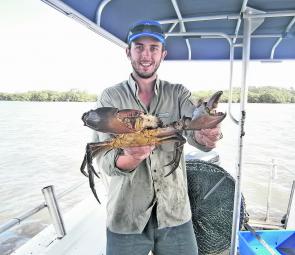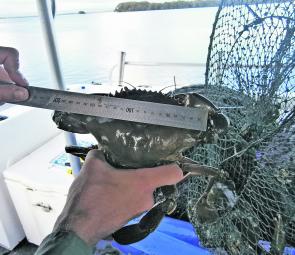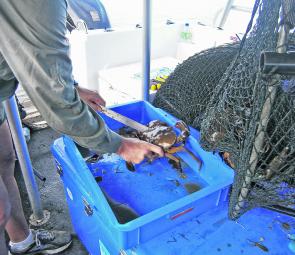Recently, Incredible Charters undertook a 4-day charter as part of an annual study of the mud crab population in and around the mouth of the Logan River.
The study was commissioned by Seqwater as part of their ongoing obligations to monitor impacts upon the nearby marine environment after the construction of Wyaralong Dam. The Mud Crab Survey is now in its 4th year and has found no impacts upon the mud crab fishery as a result of the dam’s construction, which was completed in 2011. The dam is located on the Teviot Brook, approximately 14km northwest of Beaudesert in the Logan River catchment.
The same locations are fished every year at roughly the same time and will vary due to weather conditions; as it is important to the study, the 4 consecutive nights are fished upon the full moon. Pots are strung out in sets of 10 and water quality testing for salinity, turbidity and temperature are conducted at the commencement of each run. Historical GPS marks for each string are used to ensure the same area is fished each year.
Armed with a rich-lathering of mozzie repellent, we set off each night on the incoming tide. We ran out 80 pots in the set locations under a research permit issued by Moreton Bay Marine Park and QLD Department of Primary Industry and Fisheries. All pots were set well clear of any recreational or commercial pots already fishing.
On the first night, we fished in the Logan River mouth and upstream. On the second night, we fished around Long Island and the third night, we fished around Pannikin Island. We returned each morning to collect the pots on the corresponding tide. The back deck of the boat was stacked high with crab pots, enough to fill a dozen BCF stores, all pro-sized. The big esky usually reserved for our offshore fishing haul of pearl perch, snapper and reefies was chock-a-block with several hundred whole mullet, the bait of choice. And yes, the recently painted back deck was caked in mud, but we won’t go there! All for a good cause and easily fixed.
Each crab was individually recorded with its corresponding pot number. It was sexed, measured and any unusual circumstances noted, such as shell damage, missing legs or claws or barnacles. Each crab was then returned to the water where it was caught.
Barnacles on the crabs may indicate the crab is more nomadic in nature, and spends a higher amount of time above ground and wandering. Professional crabbers refer to them as ‘school crabs’, and target them in a cat and mouse game trying to predict where they are heading and laying their strings accordingly.
It wasn’t uncommon for most pots to be standing room only, with the exception of the Logan River night, which saw most mature size crabs around the lower reaches and juvenile crabs upstream. There appeared to be a clear segregation between where the kids and the adults were residing.
The second and third nights, under the research permit, we fished in several areas of the green zones around Long and Pannikin islands and as expected, these zones held a much higher proportion of keeper males to that of areas that are open to recreational crabbing. Heaps in fact, and some absolute crackers were hauled in!
The biggest male in a green zone was 19.8cm and biggest female was 19.5cm. The most take-home males in a green zone pot was 6 (average1.5 per pot) with approximately 35% of crabs caught in the green zone being take-home males. In comparison the biggest male outside a green zone was 19.5cm and the biggest female was also 19.5cm. The most male keepers in a recreational fishing area was 4 (average 0.7 per pot) with approximately 16% of crabs caught in a recreational zone being take-home males, less than half that of the green zone.
For the record the total number of crabs caught over the three locations was 1124, broken down into 871 males (246 legal) and 253 females.
After handling, measuring and recording all those crabs, you would think a crab may have had a win and got hold of one of the guys, but not so. No injuries, just a few sore arms and backs from hand hauling 80 full size pots each morning.
If you are into mud crabbing, it would have blown your mind. Some of the sizes and the quantities landed we recorded was a great experience. The results speak for themselves. The fishery is doing very nicely and green zones do actually hold a reserve population of mature breeding stock, just as they were intended to do.
Love them or hate them, the evidence is quite conclusive that the no fish zones are important to the future sustainability of the fishery and, I must say as a previous ‘doubting Thomas’, I doubt no more!
Reads: 6973
Some of the mud crabs were huge, the biggest male went 19.8cm.

Each crab was individually recorded with its corresponding pot number. It was sexed, measured and any unusual characteristics noted. Each crab was then returned to the water where it was caught.

The evidence is quite conclusive that the no-fish zones are important to the future sustainability of the fishery.





